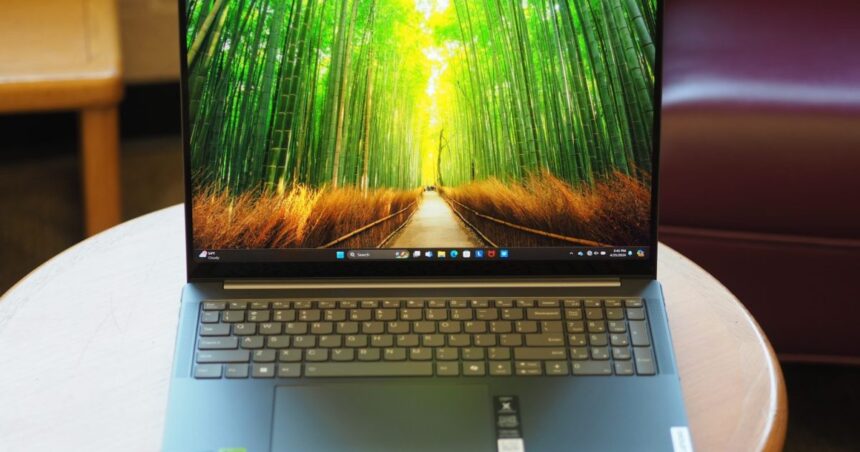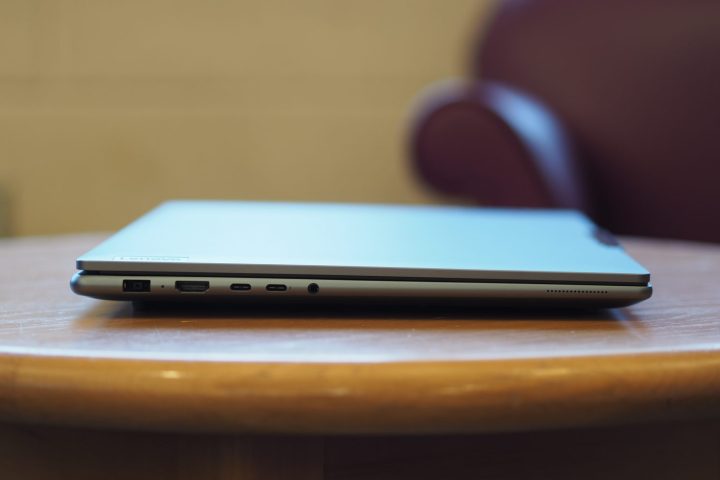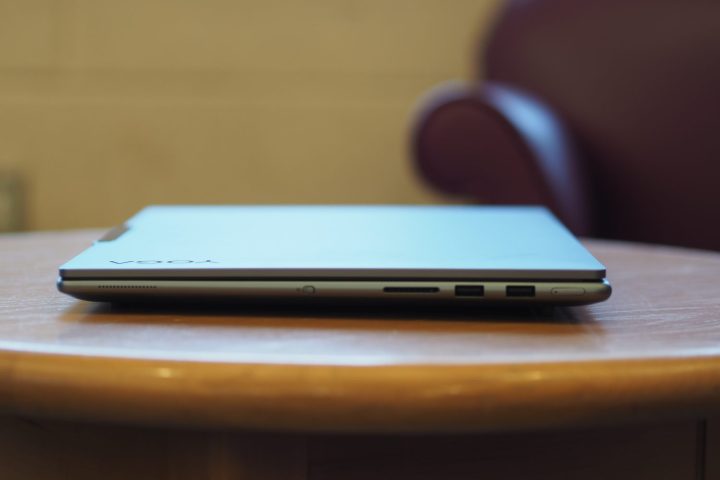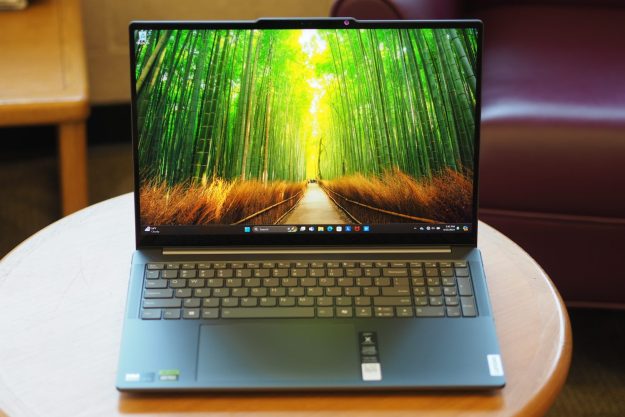
“The Lenovo Yoga Pro 9i 16 is more powerful than you might think, making it one of the best 16-inch laptops around.”
Pros
- Competitive pricing
- Excellent creativity performance
- Solid 1440p gaming
- Very good mini-LED display
- Attractive quality build
- Class-leading audio
Cons
- Display contrast isn’t the best
- Needs a haptic touchpad
There’s been a glut of 16-inch creator laptops focused on being a true competitor to the MacBook Pro. Few though, have been able to really challenge it.
When first seeing the Yoga Pro 9i 16, I assumed it would be good but ultimately fall short against Apple’s most powerful laptop. But as I tested it, I came to see just how much power Lenovo squeezed into this laptop, making for what might be the most legitimate attempt at upending the MacBook Pro.
Specs and configurations
| Lenovo Yoga Pro 9i 16 | |
| Dimensions | 14.28 inches x 9.99 inches x 0.72 inches |
| Weight | 4.52 pounds |
| Processor | Intel Core Ultra 7 155H Intel Core Ultra 9 185H |
| Graphics | Nvidia GeForce RTX 4050 Nvidia GeForce RTX 4060 |
| RAM | 16GB LPDDR5x (7467 MT/s) 32GB LPDDR5x (7467 MT/s) |
| Display | 16-inch 16:10 3.2K (3200 x 2000) IPS touch/non-touch 165Hz 16-inch 16:10 3.2K (3200 x 2000) OLED touch, 165Hz |
| Storage | 512GB SSD 1TB SSD |
| Touch | Optional |
| Ports | 1 x USB-C with Thunderbolt 4 1 x USB-C 3.2 Gen 2 2 x USB-A 3.2 Gen 1 1 x HDMI 1 x 3.5mm audio jack 1 x SD card reader |
| Wireless | Wi-Fi 6E and Bluetooth 5.3 |
| Webcam | 5MP with infrared camera for Windows 11 Hello |
| Operating system | Windows 11 |
| Battery | 84 watt-hours |
| Price |
$1,482+ |
It’s difficult sometimes to nail down Lenovo’s pricing, because it’s constantly changing. The same thing with its configurations. Right now, the Yoga Pro 9i 16 starts at $1,482 for an Intel Core Ultra 7155H chipset, 16GB of RAM, a 512GB SSD, an Nvidia GeForce RTX 4050, and a 16.0-inch 3.2K IPS display. If you configure it with a Core Ultra 9 185H, 32GB of RAM, a 1TB SSD, an RTX 4060, and a 3.2K mini-LED display, it’s $2,105.
That’s a premium price, but it’s relatively affordable given its design and performance. The Yoga Pro 9i 16 has two primary competitors today: the Dell XPS 16 and the Samsung Galaxy Book4 Ultra. Both are reasonably portable 16-inch creator laptops like the Yoga.
The XPS 16 starts at $1,899 for a Core Ultra 7 155H, 16GB of RAM, a 512GB SSD, integrated Intel Arc graphics, and a 16.3-inch Full HD+ IPS display. When configured similarly to the Yoga with a Core Ultra 9, 32GB of RAM, a 1TB SSD, an RTX 4060, and a 16.3-inch 4K+ OLED display, it costs $3,099. As we tested it, with a Core Ultra 7 155H, 32GB of RAM, a 1TB SSD, an RTX 4070, and the OLED display, it costs $3,399.
The Galaxy Book4 Ultra is also more expensive, albeit its base model is better configured. It starts at $2,400 for a Core Ultra 7 155H, 16GB of RAM, a 1TB SSD, an RTX 4050 GPU, and a 16.0-inch 3K AMOLED display. With a Core Ultra 9, 32GB of RAM, a 1TB SSD, and an RTX 4070, it costs $3,000.
As we’ll see, the Yoga Pro 9i 16 is faster than both competitors while costing $1,295 less than the XPS 16 and $895 less than the Galaxy Book4 Ultra. The Apple MacBook Pro 16 is more expensive than each of these machines by a hefty margin.
Design
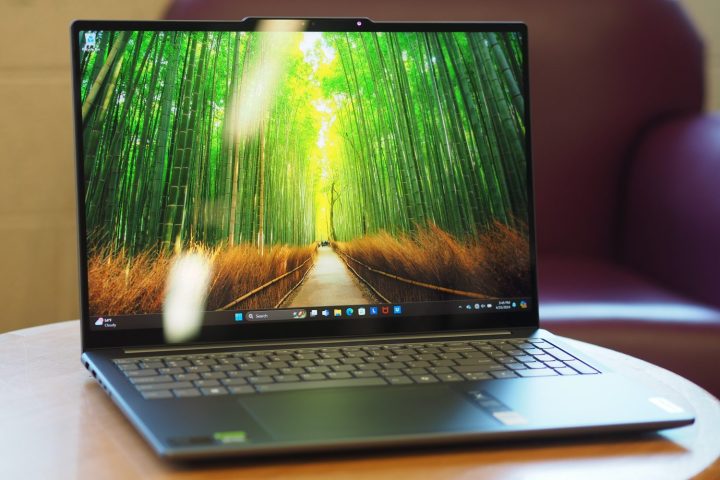
The Yoga Pro 9i 16 is a large laptop, with a 16.0-inch display with reasonably small bezels on the sides and top but a larger bottom chin than, say, the Dell XPS 16 with its class-leading bezels. That means it’s a bit deeper even though the XPS 16 has a slightly larger 16.3-inch display. The Yoga Pro is a bit thinner, though, and it’s lighter.
The MacBook Pro 16 falls in between in width and depth, but it’s significantly thinner at 0.66 inches versus the Yoga’s 0.72 inches, and the MacBook’s slightly higher weight gives it a denser feel. The Samsung Galaxy Book4 Ultra is the thinnest (0.65 inches) and lightest (4.1 pounds).
Overall, that makes the Yoga Pro 9i 16 reasonably portable for a large-screen laptop, but not class-leading. Its build quality is excellent thanks to an all-aluminum design, and there’s zero bending, flexing, or twisting in the display, keyboard deck, or chassis. It’s easily as good as the XPS 16 and MacBook Pro 16, and given its lower price, that makes it particularly impressive.
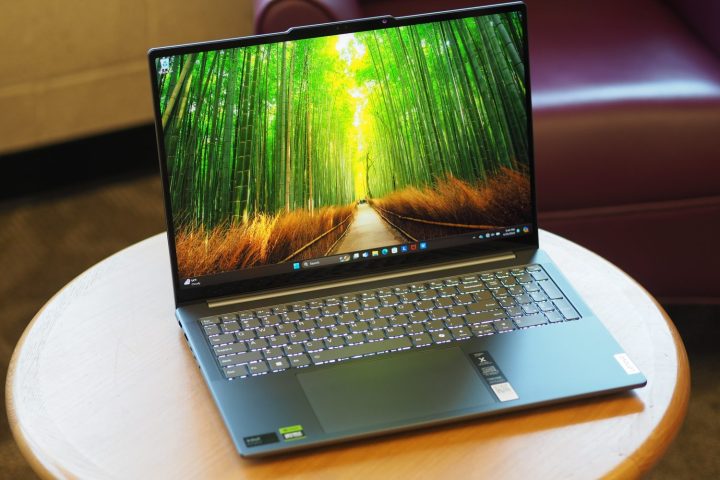
The light-gray chassis is simple in its design and features rounded edges that make it comfortable to use and carry around. The reverse notch on top of the display housing the webcam and quad microphones provides something to grab onto when opening the lid, which you can do with one hand thanks to a hinge that feels just right.
Overall, the aesthetic is minimalist but reasonably attractive. The XPS 16 has a more modern design and the MacBook Pro 16 is arguably more elegant, but you likely won’t choose either over the Yoga Pro based on looks alone.

The keyboard is Lenovo’s usual version with sculpted keycaps and plenty of key spacing, and the switches are reasonably deep and are snappy and precise. I did find the bottoming action a little stiffer than I like, and the MacBook Pro’s Magic Keyboard remains my favorite.
I was able to maintain close to my maximum typing speed when writing this review, but I did find the keyboard a little fatiguing after a while. The touchpad is large enough, but it’s a mechanical version as opposed to the haptic touchpad you’ll find on the XPS 16 and MacBook Pro 16.
While the Yoga Pro 9i 16’s version had quiet, solid clicks, I still prefer haptic touchpads at these prices for their larger clickable areas and tunable feel.
It’s also worth mentioning that the trackpad is off-center because of the inclusion of a numpad to the right of the keyboard. The Galaxy Book4 Ultra also has this same type of keyboard. Most people probably don’t need a numpad in their daily lives, making this a bit of an odd design decision to keep around.
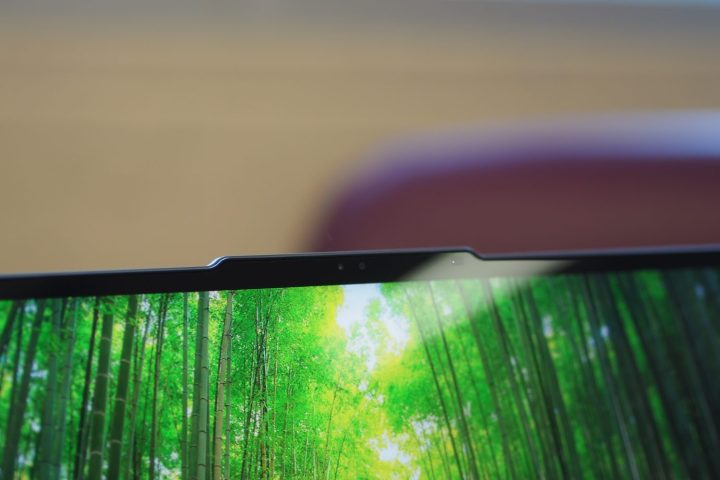
The Yoga Pro 9i 16 has a wide range of connectivity that’s in line with the usual larger laptop. There’s a mix of modern and legacy ports and a full-size SD card reader, a welcome sign for creators. The XPS 16 has more Thunderbolt 4 ports but no legacy support, and it has a microSD card reader.
The MacBook Pro 16 has the same HDMI port and full-size SD card reader but more Thunderbolt 4 connections. Wireless connectivity is modern enough.
The webcam is a 5MP version that’s higher resolution than many of its competitors, and it provides a quality image. The laptop’s Meteor Lake chipset includes a Neural Processing Unit (NPU) that’s used by Microsoft’s Studio Effects software and not much else.
Thermals and power

The Yoga Pro 9i 16 can be configured with either the 28-watt Core Ultra 7 155H with 16 cores (six Performance, eight Efficient, and two Low Power Efficient) and 22 threads running at 4.8 GHz or the 45-watt Core Ultra 9 185H with the same number of cores and threads running at up to 5.1 GHz. I reviewed a model with the latter, along with the Nvidia GeForce RTX 4060 (the RTX 4050 is an option). As I discovered in my benchmarks, specs can be deceiving, and by all accounts, the Yoga Pro 9i 16 is a spectacular performer.
As mentioned earlier, the Dell XPS 16 and Samsung Galaxy Book4 Ultra are two of Lenovo’s most important competitors here. The XPS 16 and Galaxy Book4 Ultra we reviewed both had the theoretically faster RTX 4070 while the XPS 16 had the Core Ultra 7 and the Galaxy Book4 Ultra had the Core Ultra 9.
However, Lenovo built in 130 watts of TDP to divide between the CPU and GPU, while the Dell and Samsung are both limited to just 80 watts. The RTX 4060 and RTX 4070 can take up to 115 watts, but the XPS 16 and Samsung Galaxy Book4 Ultra versions got just 60 watts. The Yoga Pro 9i 16 gives its GPU 100 watts, leaving 30 watts for the CPU. That means that both the CPU and GPU in the Lenovo get a lot more power.
I also looked at the Asus ROG Zephyrus G16, because although it’s a gaming laptop (albeit a very thin one at just 0.64 inches), it also gives its RTX 4070 a lot of power, and you would expect it to be faster. Another comparison is the Alienware m16 R2 that has a total TDP of 175 watts.
Performance
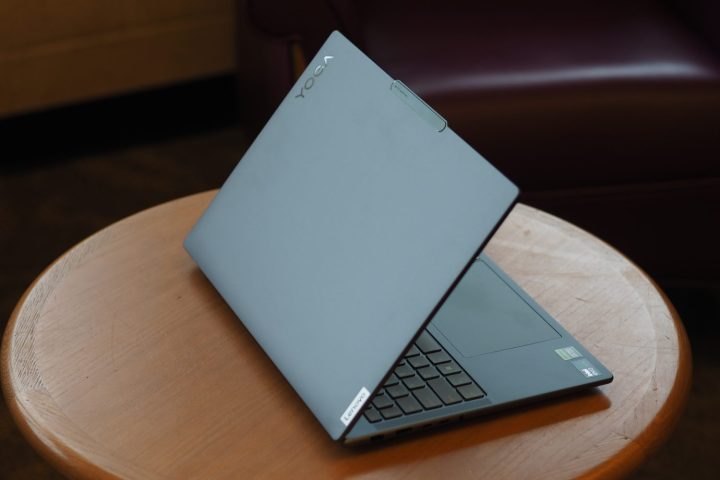
So, what do the numbers look like? I’m rarely blown away by a laptop’s performance, and when I am, it’s usually when it performs a lot better than I expected or when compared to its main competitors. The Yoga Pro 9i 16 accomplished both.
Across all our benchmarks, it’s at least as fast as the XPS 16 and the Galaxy Book4 Ultra, and in most cases it’s faster. That’s in our CPU-intensive benchmarks where I expected it to be faster than the XPS 16, but also in our GPU-specific benchmarks where I expected the Dell and Samsung to benefit from their faster GPUs. The Yoga Pro 9i 16’s was almost as fast in the Cinebench R24 GPU benchmark, and its Geekbench 6, Handbrake, and Cinebench R24 CPU scores were higher almost across the board.
Things were most interesting when looking at the real-world Pugetbench Premiere Pro benchmark, which runs in a live version of Adobe’s Premiere Pro. That benchmark tasks both the CPU and the GPU, and the latter makes a significant difference in how fast a Windows laptop can churn through various demanding processes like video encoding. The Yoga Pro 9i 16 was faster in this benchmark than both the XPS 16 and the Galaxy Book4 Ultra, and it was even faster than the Asus ROG Zephyrus G16 and Alienware m16 R2. That’s impressive given each laptop’s configuration and price.
If you’re looking for a 16-inch laptop that’s reasonably portable yet provides excellent performance, the Yoga Pro 9i 16 is a solid choice. I hope nobody looks at the RTX 4060 and decides to choose an XPS 16 or Galaxy Book4 Ultra because those laptops have an RTX 4070 as an option. The Lenovo will be faster, and it’s also significantly less expensive. Apple’s MacBook Pro 16 is a much faster laptop with its M3 Max 16/40 chipset, but it’s also incredibly costly.
| Geekbench 6 (single/multi) |
Handbrake (seconds) |
Cinebench R24 (single/multi/GPU) |
Pugetbench Premiere Pro |
|
| Lenovo Yoga Pro 9i 16 (Core Ultra 9 185H / RTX 4060) |
Bal: 2,396 / 14,270 Perf: 2,426 / 14,406 |
Bal: 59 Perf: 54 |
Bal: 110 / 1,085 / 9,859 Perf: 112 / 1,115 / 10,415 |
Bal: 5,774 Perf: 6,112 |
| Dell XPS 16 (Core Ultra 7 155H / RTX 4070) |
Bal: 2,196 / 12,973 Perf: 2,238 / 12,836 |
Bal: 72 Perf: 73 |
Bal: 100 / 838 / 9,721 Perf: 102 / 895 / 10,477 |
Bal: 5,401 Perf: 5,433 |
| Samsung Galaxy Book4 Ultra (Core Ultra 185H / RTX 4070) |
Bal: 2,373 / 13,082 Perf: 2,331 / 13,381 |
N/A | Bal: 107 / 817 / 8,994 Perf: 106 / 985 / 10,569 |
Bal: 3,906 Perf: 5,669 |
| Asus ROG Zephyrus G16 (Core Ultra 9 185H / RTX 4070) |
N/A | N/A | Bal: 109 / 964 / 10,979 Perf: 110 / 1,069 / 11,475 |
Bal: 5,073 Perf: 5,115 |
| Alienware m16 R2 (Core Ultra 7 155H / RTX 4070) |
Bal: 2,366 / 12,707 Perf: N/A |
N/A | Bal: 103 / 1,040 / 10,884 Perf: N/A |
Bal: 5,590 Perf: N/A |
| Apple MacBook Pro 16 (M3 Max 16/40) |
Bal: 3,083 / 20,653 Perf: 3,119 / 20,865 |
Bal: 55 Perf: N/A |
Bal: 140 / 1,667 / 13,146 Perf: N/A |
Bal: 8,046 Perf: N/A |
For gamers, the Yoga Pro 9i 16 continues its surprising performance. Lenovo uses Nvidia’s Studio drivers, and so its gaming performance is sacrificed a bit in exchange for better and more reliable performance in creative and other apps. Even so, it did well.
To begin with, I ran the 3DMark Time Spy test and, once again, Lenovo squeezed a lot more out of the RTX 4060 than some of its competitors did their RTX 4070s. Here, even the ROG Zephyrus G16 wasn’t as fast. Both of the Yoga’s display options run at 165Hz, so that virtually ensures a tear-free experience given the GPU.
I also ran a couple of gaming benchmarks, and the Yoga Pro 9i 16 was again a strong performer. When pitted against a few laptops with RTX 4070s, including a couple of gaming machines, the Lenovo did surprisingly well.
You might want to dial back to 1080p with modern titles to enjoy the highest graphics settings. But as an occasional gaming laptop, the Yoga Pro 9i is a great choice.
| 3DMark Time Spy |
Assassin’s Creed Valhalla 1600p Ultra High |
Red Dead Redemption 1440p Ultra |
|
| Lenovo Yoga Pro 9i 16 (Core Ultra 9 185H / RTX 4060) |
Bal: 10,733 Perf: 12,832 |
Bal: 102 fps Perf: 119 fps |
Bal: 59 Perf: 69 fps |
| Dell XPS 16 (Core Ultra 7 155H / RTX 4070) |
Bal: 8,216 Perf: 9,352 |
Bal: 83 fps Perf: 104 fps |
Bal: 62 fps Perf: 66 fps |
| Samsung Galaxy Book4 Ultra (Core Ultra 7 155H / RTX 4070) |
Bal: 7,242 Perf: 10,207 |
N/A | N/A |
| Asus ROG Zephyrus G16 (Core Ultra 9 185H / RTX 4070) |
Bal: 10,828 Perf: 12,159 |
N/A | Bal: 58 fps Perf: 68 fps |
| Alienware m16 R2 (Core Ultra 7 155H / RTX 4070) |
Bal: 12,025 Perf: N/A |
N/A | Bal: 69 fps Perf: N/A |
Battery life
The Yoga Pro 9i 16 has an 84-watt-hour battery, which is on the low side for a 16-inch laptop with fast components and a high-res, power-hungry mini-LED display. I wasn’t expecting great battery life, and I didn’t get it. But what I saw was decent enough.
It managed around six hours in our web browsing test and 9.5 hours in our video test. Those are below average across all Windows laptops, but they’re not bad at all for this class of machine. The XPS 16 has a 99.5-watt-hour battery, and it lasted for just 5.5 hours in each test.
While the Yoga Pro 9i 16 doesn’t come anywhere near the MacBook Pro 16’s 19 hours of web browsing and 27 hours of video, it still does well compared to its slightly more expensive competition. It won’t last much past lunch doing any kind of work, but that’s to be expected until Intel and Microsoft come up with a more efficient solution that still hits top speeds when needed.
Display and audio
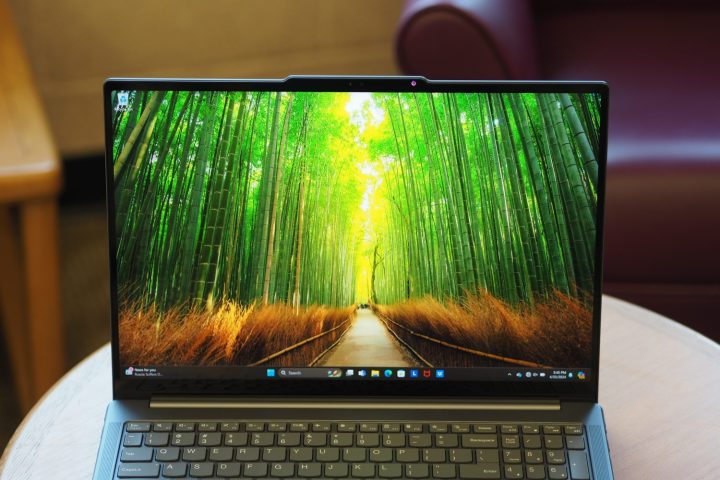
Lenovo went with a mini-LED display for the Yoga Pro 9i 16, specifically a 16.0-inch 16:10 panel at 3.2K (3000 x 2000) resolution. That’s plenty sharp, and with a 165Hz refresh rate, Windows 11 is buttery smooth.
Mini-LED is known for intense brightness and deep contrast, and they shine (no pun intended) in Apple’s MacBook Pros. When I reviewed the 2023 Yoga Pro 9i 16, though, I wasn’t as impressed. Its mini-LED display was bright and colorful, but its contrast wasn’t as high. When I switched into HDR mode in Windows display settings, contrast was higher but colors were much worse. That’s just how Windows handles HDR content.
I saw the same thing with the 2024 Yoga Pro 9i 16. It showed wide and accurate colors and plenty of brightness. It did well with HDR video from sources like Netflix, thanks to Dolby Vision HDR support, but its contrast was lower than the MacBook Pro’s mini-LED displays and OLED panels. And contrast was higher when HDR was switched on.
In any event, the Yoga Pro 9i 16’s display is very good for productivity users, creators, and media consumers. If you want the best HDR support in content and gaming, you’ll want to switch HDR on.
| Brightness |
AdobeRGB |
DCI-P3 | Accuracy |
Contrast | |
| Lenovo Yoga Pro 9i 16 (mini-LED) |
652 nits | 88% | 98% | DeltaE 0.66 | 2,360:1 |
| Dell XPS 16 (OLED) |
432 nits | 90% | 100% | DeltaE 0.59 | N/A |
| Samsung Galaxy Book4 Ultra (AMOLED) |
376 nits | 96% | 100% | DeltaE 0.74 | 16,040:1 |
| MacBook Pro 16 (mini-LED) |
640 nits | 89% | 100% | DeltaE 1.22 | 22,150:1 |
| Dell XPS 17 (IPS) |
501 | 100% | 97% | DeltaE 1.33 | 1,570:1 |
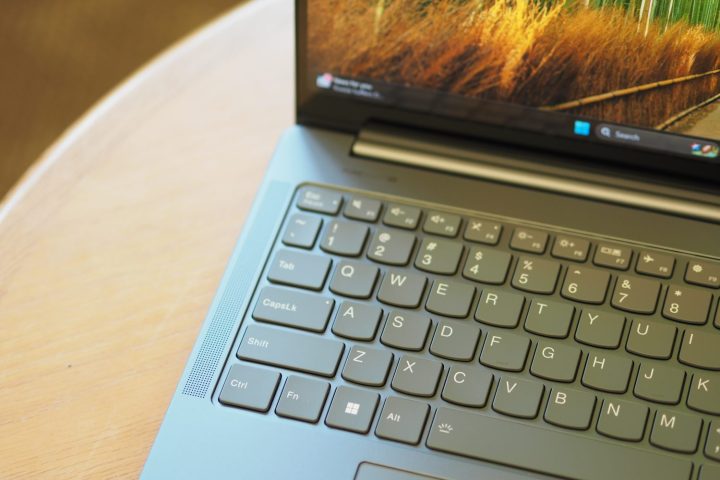
The Yoga Pro 9i 16 has six speakers, two upward-firing tweeters, and four side-firing woofers. The system puts out a lot of volume without distorting, and highs and mids are nice and bright. There’s also more bass than you’ll find in most laptops. After listening to them side-by-side, I still give the nod to the MacBook Pro 16’s six-speaker setup, but the Yoga comes in a close second. The Lenovo’s audio is noticeably better than the XPS 16’s, with more bass and less distortion at full volume.
A surprisingly strong entry in the 16-inch sweepstakes
The most notable names in 16-inch laptops today are the XPS 16 and the MacBook Pro 16. Those two machines get most of the press, while the Yoga Pro 9i 16 is more of a dark horse. But I hope that changes, because it’s a truly excellent laptop that’s available for a relatively attractive price.
While it can’t keep up with the class-leading MacBook Pro’s performance and efficiency, it’s faster than competing Windows laptops even when they equip a faster GPU. Lenovo gave the Yoga Pro 9i 16 more power, and it shows. Toss in a great display and sound system to go with a solid build, and the Yoga Pro 9i 16 is one of the best 16-inch laptops around.
Editors’ Recommendations
